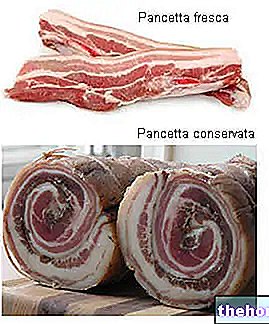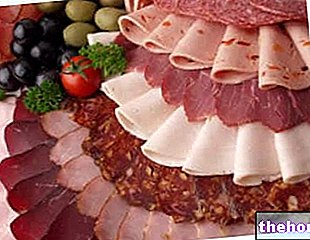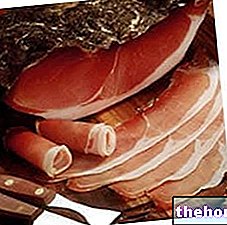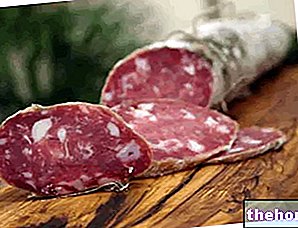Generality
The raw ham is a preserved meat, or rather, a raw cured meat, seasoned, NOT stuffed and almost totally coated.

NB. Often, raw ham is marketed in much smaller cuts (similar to slices) but these too are made from the whole cured leg of the pig.
The production of raw ham is the result of the salting (dehydration) and seasoning of the pork leg; it is an extremely synthetic and apparently simple procedure (especially when compared to that of cooked ham) but remarkably delicate and with a high error rate.
Production
The production of raw ham takes place for:
- Selection of the thighs: first of all, it is necessary to specify that the pigs for the production of raw ham are a "separate breeding", ie they are herds previously destined for this type of supply chain; obviously, the rest of the animal is still used for food, BUT the diet, lifestyle, veterinary care, etc. are aimed at obtaining the most suitable thighs for the production of raw ham. In some cases, at the time of "purchase, the animals are selected alive, while in others, the sorting takes place on the leg already slaughtered.
NB. The variables to consider in choosing the beast or the thigh are different; the most important ones concern the size and the level of fatness. - Drying of the legs: it takes place for several days at a temperature of 3-4 ° C
- Salting of the legs: the hams, to dehydrate and then mature, must be sprinkled with salt or immersed in brine; the mixture used for the salting of raw ham contains: sodium chloride, flavorings, nitrates and, in some cases, sucrose.
NB. The percentages of salting are necessary for the success of the food - Pre-rest and rest: phases in which the hams begin to change their nutritional composition and the percentage of water they contain
- Washing: it is aimed at eliminating the external residues of raw ham (salt, liquids, impurities, etc.)
- Drying / drying: in this phase the hams are passed into a special dryer to be carefully dried from excess liquids
- Sugnatura: as anticipated, the portion of meat uncovered and not provided with rind must be sprinkled with lard; this process is essential so that the raw ham is preserved "entirely" and does not have any spoiled portion even in the vicinity of the areas without rind
- Grooming: very simply, the smoked hams are then scrutinized and "corrected" before the next stage of processing
- Pre-curing and curing: phases of actual maturation of raw ham that can end positively only if the previous steps have been carried out flawlessly
- Pointing: this is the "final examination" of raw ham; by means of pointing, a specialized operator verifies the organoleptic properties of the food, the presence or absence of defects and assesses its suitability for placing on the market. NB. The evaluation criteria are different based on the presence or absence of the IGP or DOP marks
- Marking: lasts from 6 to 14 months (depending on the product to be obtained) and takes place ONLY in case of achievement of the quality standards verified in the spot welding and required by the production specification.
Risotto with Prosciutto and Melon
Problems with playing the video? Reload the video from youtube.
- Go to the Video Page
- Go to the Video Recipes Section
- Watch the video on youtube
Nutritional characteristics
Raw ham is a preserved meat.
The amount of sodium, total fat and calories vary considerably according to the type of raw ham analyzed, even if on average they represent foods CONTRAINDICATED in the "diet of the hypertensive" and (the fatter ones) in the diet of the hypercholesterolemic or in the hypocaloric one against overweight. On the other hand, observing the saturated lipid and cholesterol content of defatted hams, it might be possible to contextualise them easily even in diets with lower calories, saturated fatty acids and cholesterol.
As far as mineral salts are concerned, raw ham represents a valid alternative to fresh meat and (since it is greatly appreciated) it facilitates the achievement of the recommended iron rations in fertile women. The quantities of potassium and phosphorus are also appreciable while, from a vitamin point of view, raw ham boasts good rations of thiamin (vit. B1) and niacin (vit. PP).
What unites ALL raw hams is the "impertinence in the diet of pregnant women. This" special physiological condition "requires a level of food hygiene that is nothing short of excellent and preventive against parasites and / or food poisoning; such a requirement excludes the overwhelming majority of raw foods including raw ham.
Not to be underestimated, the contribution of nitrates contained in it; these preservatives (added externally during salting) are related to the onset of carcinogenic nitrosamines and therefore, although it can be considered one of the most balanced cured meats, raw ham should also be used sporadically or occasionally.
Raw Ham Nutritional Values
Nutritional composition of raw ham - Reference values of the INRAN Food Composition Tables








Other Foods - Cured Meats and Sausages Bresaola Cotechino Culatello Guanciale Sausages Lard Mortadella Bacon Raw Ham Cooked Ham Ham Spanish Ham Salami Sausage Blood Pudding Speck Wurstel Zampone OTHER ARTICLES SALAMI Categories Alcoholic Food Meat Cereals and derivatives Sweeteners Sweets Offal Dried fruit Legs and Derivatives Milk and Derivatives Fish and fishery products Cured meats Spices Vegetables Health recipes Appetizers Bread, Pizza and Brioche First courses Second courses Vegetables and Salads Sweets and Desserts Ice creams and sorbets Syrups, liqueurs and grappa Basic Preparations ---- In the kitchen with leftovers Carnival recipes Christmas recipes Light diet recipes Women's, mom's and dad's day recipes Functional recipes International recipes Easter recipes Celiac recipes Diabetic recipes Holiday recipes Valentine's Day recipes Vegetarian recipes Protein recipes Regional recipes Vegan recipes




























